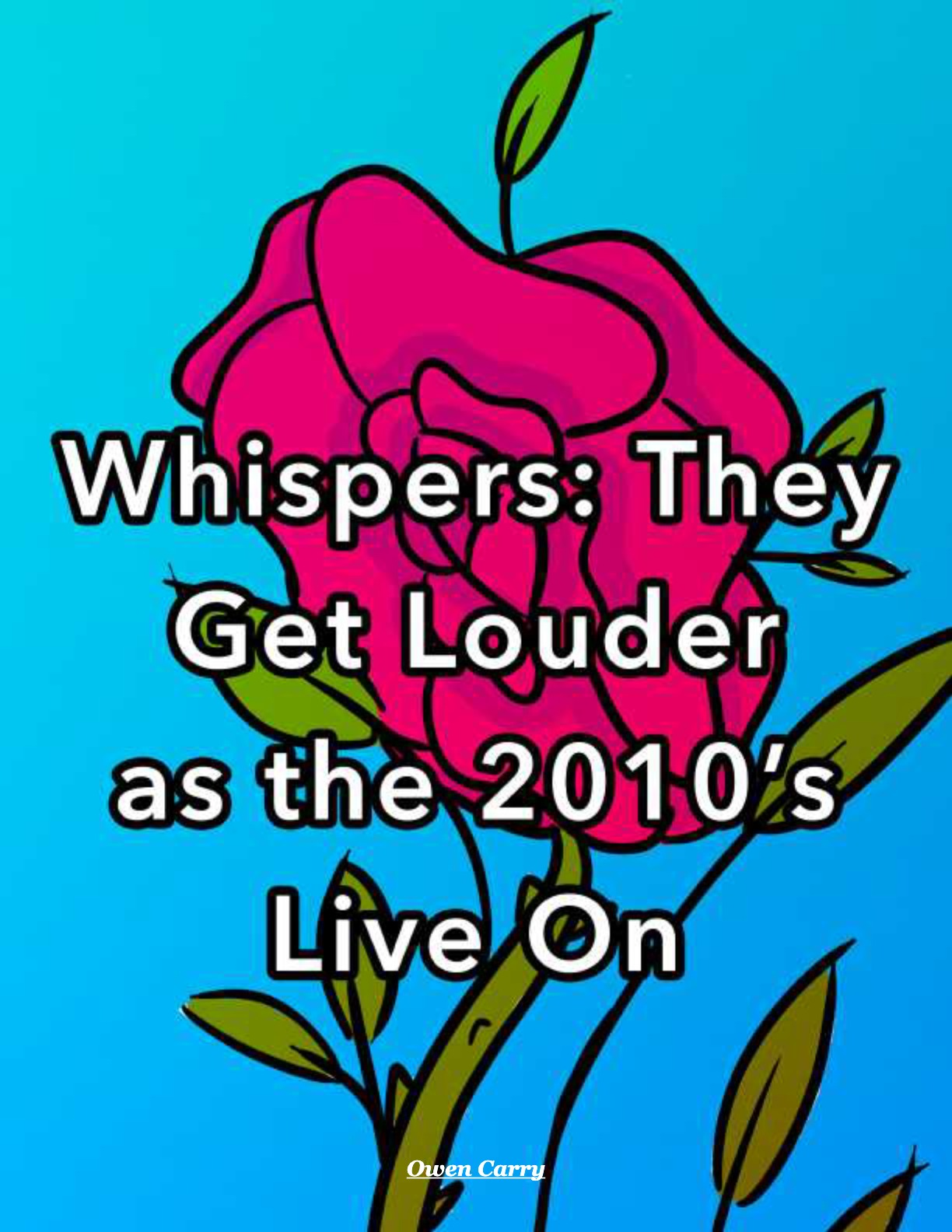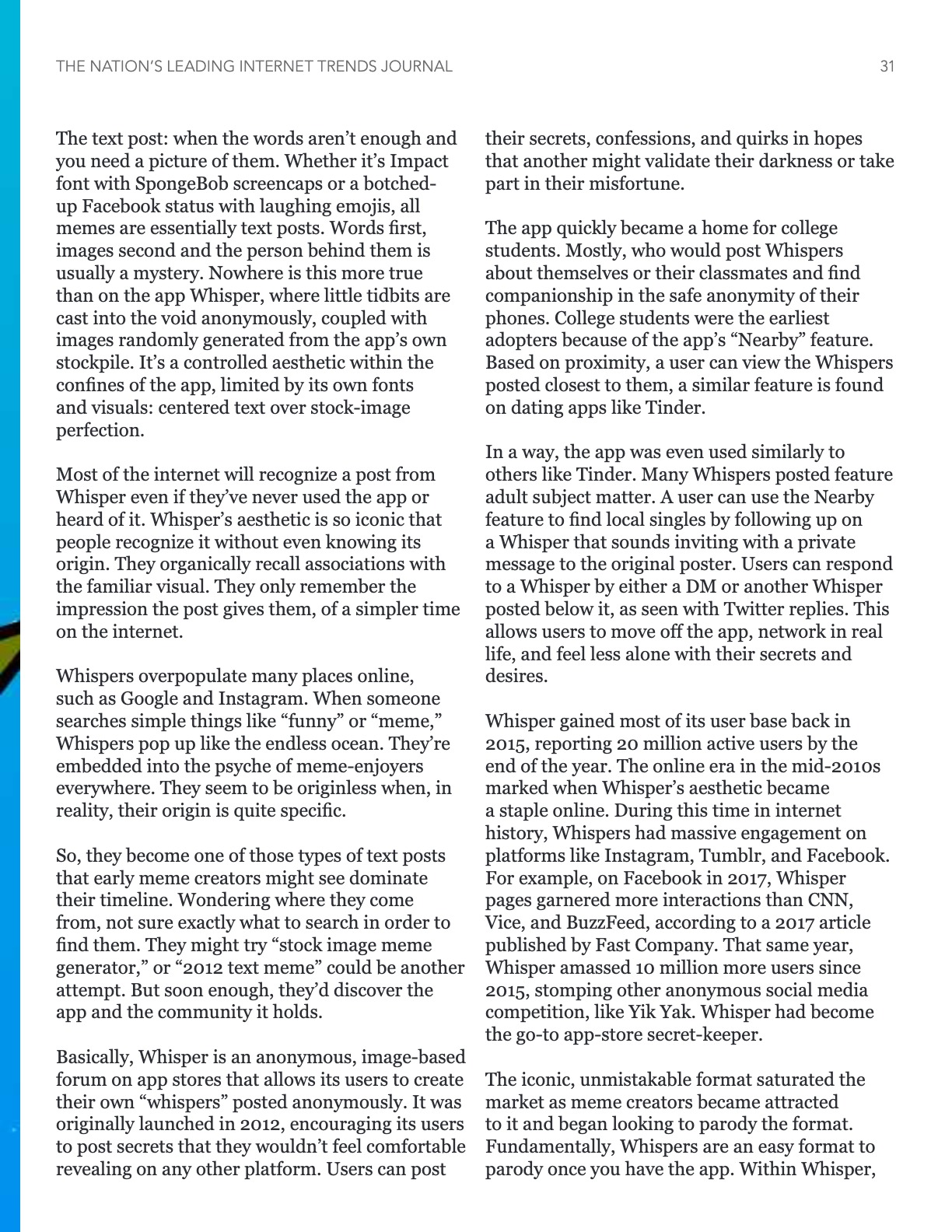Whispers
They Get Louder As The 2010s Live On

The text post: when the words aren’t enough and you need a picture of them. Whether it’s Impact font with SpongeBob screencaps or a botched-up Facebook status with laughing emojis, all memes are essentially text posts. Words first, images second and the person behind them is usually a mystery. Nowhere is this more true than on the app Whisper, where little tidbits are cast into the void anonymously, coupled with images randomly generated from the app's own stockpile. It’s a controlled aesthetic within the confines of the app, limited by its own fonts and visuals: centered text over stock-image perfection.
Most of the internet will recognize a post from Whisper even if they’ve never used the app or heard of it. Whisper’s aesthetic is so iconic that people recognize it without even knowing its origin. They organically recall associations with the familiar visual. They only remember the impression the post gives them, of a simpler time on the internet.
Whispers overpopulate many places online, such as Google and Instagram. When someone searches simple things like “funny” or “meme,” Whispers pop up like the endless ocean. They’re embedded into the psyche of meme-enjoyers everywhere. They seem to be originless when, in reality, their origin is quite specific.
So, they become one of those types of text posts that early meme creators might see dominate their timeline. Wondering where they come from, not sure exactly what to search in order to find them. They might try “stock image meme generator,” or “2012 text meme” could be another attempt. But soon enough, they’d discover the app and the community it holds.
Basically, Whisper is an anonymous, image-based forum on app stores that allows its users to create their own “whispers” posted anonymously. It was originally launched in 2012, encouraging its users to post secrets that they wouldn’t feel comfortable revealing on any other platform. Users can post their secrets, confessions, and quirks in hopes that another might validate their darkness or take part in their misfortune.
The app quickly became a home for college students. Mostly, who would post Whispers about themselves or their classmates and find companionship in the safe anonymity of their phones. College students were the earliest adopters because of the app’s “Nearby” feature. Based on proximity, a user can view the Whispers posted closest to them, a similar feature is found on dating apps like Tinder.
In a way, the app was even used similarly to others like Tinder. Many Whispers posted feature adult subject matter. A user can use the Nearby feature to find local singles by following up on a Whisper that sounds inviting with a private message to the original poster. Users can respond to a Whisper by either a DM or another Whisper posted below it, as seen with Twitter replies. This allows users to move off the app, network in real life, and feel less alone with their secrets and desires.
Whisper gained most of its user base back in 2015, reporting 20 million active users by the end of the year. The online era in the mid-2010s marked when Whisper’s aesthetic became a staple online. During this time in internet history, Whispers had massive engagement on platforms like Instagram, Tumblr, and Facebook. For example, on Facebook in 2017, Whisper pages garnered more interactions than CNN, Vice, and BuzzFeed, according to a 2017 article published by Fast Company. That same year, Whisper amassed 10 million more users since 2015, stomping other anonymous social media competition, like Yik Yak. Whisper had become the go-to app-store secret-keeper.
The iconic, unmistakable format saturated the market as meme creators became attracted to it and began looking to parody the format. Fundamentally, Whispers are an easy format to parody once you have the app. Within Whisper, it’s easy to troll and misdirect. Goofballs and shitposters alike began to use the app’s anonymity and simple format to birth strange characters into existence: ones who pregame before AA meetings or ones who believe their dog is “toxic.” They’d couple this caption with a sunset behind it or a picture of an ashtray with cascading smoke billowing through sunlight. The app suggests more and more photos to use as background options, and the meme creator then gets an algorithmic sampler platter, specifically curated, letting them roll in the irony of their choosing.
Anything can be stated in a Whisper without question. The app will just play along, providing that endless stream of images curated behind the most outrageous of statements: An organic completion for any rookie creator. There’s something about a Whisper that gives automatic validity to its poster. All internet humor is essentially this balance between believable and absurd, and the best Whispers are a representation of this balance filtered through the blossoming aesthetic of the mid-2010s.
As a new generation grows older, a different time period becomes the new nuance. New images and themes become nostalgic and a younger audience plays off this transition. Again, this could be another reason why Whisper posts, no matter how absurd, always seem to leave the possibility of a plausible poster. Because, as the aesthetic enters internet antiquity, of a “simpler time” with “simpler users,” the content of those users can be stretched into anything believable within the Whisper format.
Impact fonts and Rage Comics saw a similar evolution in the last few years. They could be recalled, remixed, and refashioned into new territories of internet irony, banking off the perceived simplicity of the late 2000s. Whispers are now entering that same stage of recall as the world enters 2021.
On Twitter recently and Instagram alike, accounts have been generating new Whisper content and blowing up because of it. On Twitter right now, accounts that just post Whispers are going viral. Take the account @whispers_finest, which only joined in December 2020 and already has 127,000 followers and counting. Daily, it posts Whisper after Whisper whose themes and buzzwords deal mainly with 2021 trends. Many of them namedrop James Charles or Zoom University. Whispers on these new Twitter and Instagram pages complain about the coronavirus or use AOC’s likeness for easy clicks. It’s a mix between old and new, with the ones from modern times indistinguishable from those of old. All of them represented in the 2010s time capsule that is the Whisper.
During these times, when people are remaining quarantined in their homes, Whisper has the ability to connect strangers together through both anonymity and proximity. People are lonely right now, and casting a thought into the void to blend in with all the other thoughts (in a visual sense) makes them feel less alone. And hey, the people online today are younger than they’ve ever been … and they’re only getting younger. They look to the time of the internet when they were young. Whispers being the primary means of this nostalgia, recalling it, remixing it, and finding irony in this aesthetic that’s familiar.
It makes one wonder if Whisper has seen an increase in users in 2021. Now that they’ve gone mainstream ironically, will people flock back to the app to unlock its origins? Hopefully, there’s a recount soon because 2017 is a long way from now. Maybe it’s time we ditch all the personal pages, the ones with our names and faces attached. Maybe it’s time we stop choosing our own images, let our captions go out there, and allow Whisper to fill in the rest. Just post into the void using those same old fonts on the same old app.
Most of the internet will recognize a post from Whisper even if they’ve never used the app or heard of it. Whisper’s aesthetic is so iconic that people recognize it without even knowing its origin. They organically recall associations with the familiar visual. They only remember the impression the post gives them, of a simpler time on the internet.
Whispers overpopulate many places online, such as Google and Instagram. When someone searches simple things like “funny” or “meme,” Whispers pop up like the endless ocean. They’re embedded into the psyche of meme-enjoyers everywhere. They seem to be originless when, in reality, their origin is quite specific.
So, they become one of those types of text posts that early meme creators might see dominate their timeline. Wondering where they come from, not sure exactly what to search in order to find them. They might try “stock image meme generator,” or “2012 text meme” could be another attempt. But soon enough, they’d discover the app and the community it holds.
Basically, Whisper is an anonymous, image-based forum on app stores that allows its users to create their own “whispers” posted anonymously. It was originally launched in 2012, encouraging its users to post secrets that they wouldn’t feel comfortable revealing on any other platform. Users can post their secrets, confessions, and quirks in hopes that another might validate their darkness or take part in their misfortune.
The app quickly became a home for college students. Mostly, who would post Whispers about themselves or their classmates and find companionship in the safe anonymity of their phones. College students were the earliest adopters because of the app’s “Nearby” feature. Based on proximity, a user can view the Whispers posted closest to them, a similar feature is found on dating apps like Tinder.
In a way, the app was even used similarly to others like Tinder. Many Whispers posted feature adult subject matter. A user can use the Nearby feature to find local singles by following up on a Whisper that sounds inviting with a private message to the original poster. Users can respond to a Whisper by either a DM or another Whisper posted below it, as seen with Twitter replies. This allows users to move off the app, network in real life, and feel less alone with their secrets and desires.
Whisper gained most of its user base back in 2015, reporting 20 million active users by the end of the year. The online era in the mid-2010s marked when Whisper’s aesthetic became a staple online. During this time in internet history, Whispers had massive engagement on platforms like Instagram, Tumblr, and Facebook. For example, on Facebook in 2017, Whisper pages garnered more interactions than CNN, Vice, and BuzzFeed, according to a 2017 article published by Fast Company. That same year, Whisper amassed 10 million more users since 2015, stomping other anonymous social media competition, like Yik Yak. Whisper had become the go-to app-store secret-keeper.
The iconic, unmistakable format saturated the market as meme creators became attracted to it and began looking to parody the format. Fundamentally, Whispers are an easy format to parody once you have the app. Within Whisper, it’s easy to troll and misdirect. Goofballs and shitposters alike began to use the app’s anonymity and simple format to birth strange characters into existence: ones who pregame before AA meetings or ones who believe their dog is “toxic.” They’d couple this caption with a sunset behind it or a picture of an ashtray with cascading smoke billowing through sunlight. The app suggests more and more photos to use as background options, and the meme creator then gets an algorithmic sampler platter, specifically curated, letting them roll in the irony of their choosing.
Anything can be stated in a Whisper without question. The app will just play along, providing that endless stream of images curated behind the most outrageous of statements: An organic completion for any rookie creator. There’s something about a Whisper that gives automatic validity to its poster. All internet humor is essentially this balance between believable and absurd, and the best Whispers are a representation of this balance filtered through the blossoming aesthetic of the mid-2010s.
As a new generation grows older, a different time period becomes the new nuance. New images and themes become nostalgic and a younger audience plays off this transition. Again, this could be another reason why Whisper posts, no matter how absurd, always seem to leave the possibility of a plausible poster. Because, as the aesthetic enters internet antiquity, of a “simpler time” with “simpler users,” the content of those users can be stretched into anything believable within the Whisper format.
Impact fonts and Rage Comics saw a similar evolution in the last few years. They could be recalled, remixed, and refashioned into new territories of internet irony, banking off the perceived simplicity of the late 2000s. Whispers are now entering that same stage of recall as the world enters 2021.
On Twitter recently and Instagram alike, accounts have been generating new Whisper content and blowing up because of it. On Twitter right now, accounts that just post Whispers are going viral. Take the account @whispers_finest, which only joined in December 2020 and already has 127,000 followers and counting. Daily, it posts Whisper after Whisper whose themes and buzzwords deal mainly with 2021 trends. Many of them namedrop James Charles or Zoom University. Whispers on these new Twitter and Instagram pages complain about the coronavirus or use AOC’s likeness for easy clicks. It’s a mix between old and new, with the ones from modern times indistinguishable from those of old. All of them represented in the 2010s time capsule that is the Whisper.
During these times, when people are remaining quarantined in their homes, Whisper has the ability to connect strangers together through both anonymity and proximity. People are lonely right now, and casting a thought into the void to blend in with all the other thoughts (in a visual sense) makes them feel less alone. And hey, the people online today are younger than they’ve ever been … and they’re only getting younger. They look to the time of the internet when they were young. Whispers being the primary means of this nostalgia, recalling it, remixing it, and finding irony in this aesthetic that’s familiar.
It makes one wonder if Whisper has seen an increase in users in 2021. Now that they’ve gone mainstream ironically, will people flock back to the app to unlock its origins? Hopefully, there’s a recount soon because 2017 is a long way from now. Maybe it’s time we ditch all the personal pages, the ones with our names and faces attached. Maybe it’s time we stop choosing our own images, let our captions go out there, and allow Whisper to fill in the rest. Just post into the void using those same old fonts on the same old app.
click here to read this article in the March 2021 Meme Insider issue.



©owencarry.com